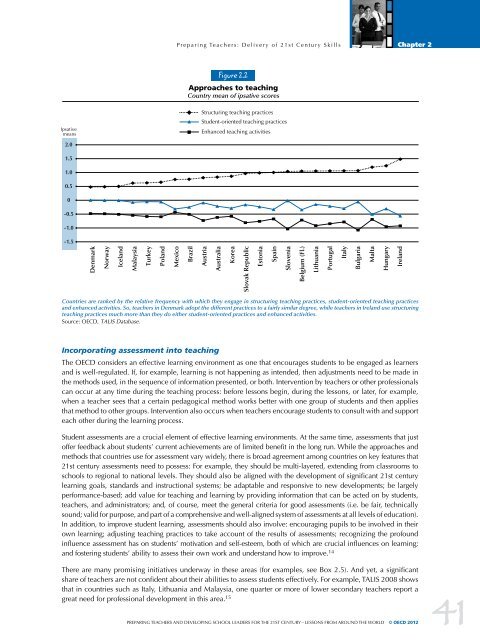Preparing Teachers and Developing School Leaders for the 21st Century
Preparing Teachers and Developing School Leaders for the 21st Century
Preparing Teachers and Developing School Leaders for the 21st Century
You also want an ePaper? Increase the reach of your titles
YUMPU automatically turns print PDFs into web optimized ePapers that Google loves.
Ipsative<br />
means<br />
2.0<br />
1.5<br />
1.0<br />
0.5<br />
0<br />
-0.5<br />
-1.0<br />
-1.5<br />
Denmark<br />
Norway<br />
Icel<strong>and</strong><br />
Malaysia<br />
Turkey<br />
Pol<strong>and</strong><br />
Incorporating assessment into teaching<br />
<strong>Preparing</strong> teachers: delivery of <strong>21st</strong> century skills<br />
Mexico<br />
Figure 2.2<br />
Approaches to teaching<br />
Country mean of ipsative scores<br />
Brazil<br />
Structuring teaching practices<br />
Student-oriented teaching practices<br />
Enhanced teaching activities<br />
Austria<br />
Australia<br />
Korea<br />
Chapter 2<br />
Countries are ranked by <strong>the</strong> relative frequency with which <strong>the</strong>y engage in structuring teaching practices, student-oriented teaching practices<br />
<strong>and</strong> enhanced activities. So, teachers in Denmark adopt <strong>the</strong> different practices to a fairly similar degree, while teachers in Irel<strong>and</strong> use structuring<br />
teaching practices much more than <strong>the</strong>y do ei<strong>the</strong>r student-oriented practices <strong>and</strong> enhanced activities.<br />
Source: OECD, TALIS Database.<br />
<strong>the</strong> oecd considers an effective learning environment as one that encourages students to be engaged as learners<br />
<strong>and</strong> is well-regulated. if, <strong>for</strong> example, learning is not happening as intended, <strong>the</strong>n adjustments need to be made in<br />
<strong>the</strong> methods used, in <strong>the</strong> sequence of in<strong>for</strong>mation presented, or both. intervention by teachers or o<strong>the</strong>r professionals<br />
can occur at any time during <strong>the</strong> teaching process: be<strong>for</strong>e lessons begin, during <strong>the</strong> lessons, or later, <strong>for</strong> example,<br />
when a teacher sees that a certain pedagogical method works better with one group of students <strong>and</strong> <strong>the</strong>n applies<br />
that method to o<strong>the</strong>r groups. intervention also occurs when teachers encourage students to consult with <strong>and</strong> support<br />
each o<strong>the</strong>r during <strong>the</strong> learning process.<br />
student assessments are a crucial element of effective learning environments. at <strong>the</strong> same time, assessments that just<br />
offer feedback about students’ current achievements are of limited benefit in <strong>the</strong> long run. While <strong>the</strong> approaches <strong>and</strong><br />
methods that countries use <strong>for</strong> assessment vary widely, <strong>the</strong>re is broad agreement among countries on key features that<br />
<strong>21st</strong> century assessments need to possess: <strong>for</strong> example, <strong>the</strong>y should be multi-layered, extending from classrooms to<br />
schools to regional to national levels. <strong>the</strong>y should also be aligned with <strong>the</strong> development of significant <strong>21st</strong> century<br />
learning goals, st<strong>and</strong>ards <strong>and</strong> instructional systems; be adaptable <strong>and</strong> responsive to new developments; be largely<br />
per<strong>for</strong>mance-based; add value <strong>for</strong> teaching <strong>and</strong> learning by providing in<strong>for</strong>mation that can be acted on by students,<br />
teachers, <strong>and</strong> administrators; <strong>and</strong>, of course, meet <strong>the</strong> general criteria <strong>for</strong> good assessments (i.e. be fair, technically<br />
sound; valid <strong>for</strong> purpose, <strong>and</strong> part of a comprehensive <strong>and</strong> well-aligned system of assessments at all levels of education).<br />
in addition, to improve student learning, assessments should also involve: encouraging pupils to be involved in <strong>the</strong>ir<br />
own learning; adjusting teaching practices to take account of <strong>the</strong> results of assessments; recognizing <strong>the</strong> profound<br />
influence assessment has on students’ motivation <strong>and</strong> self-esteem, both of which are crucial influences on learning;<br />
<strong>and</strong> fostering students’ ability to assess <strong>the</strong>ir own work <strong>and</strong> underst<strong>and</strong> how to improve. 14<br />
<strong>the</strong>re are many promising initiatives underway in <strong>the</strong>se areas (<strong>for</strong> examples, see Box 2.5). <strong>and</strong> yet, a significant<br />
share of teachers are not confident about <strong>the</strong>ir abilities to assess students effectively. <strong>for</strong> example, talis 2008 shows<br />
that in countries such as italy, lithuania <strong>and</strong> Malaysia, one quarter or more of lower secondary teachers report a<br />
great need <strong>for</strong> professional development in this area. 15<br />
Slovak Republic<br />
Estonia<br />
Spain<br />
PreParing teachers <strong>and</strong> develoPing school leaders <strong>for</strong> <strong>the</strong> <strong>21st</strong> century – lessons froM around <strong>the</strong> World © OECD 2012<br />
Slovenia<br />
Belgium (Fl.)<br />
Lithuania<br />
Portugal<br />
Italy<br />
Bulgaria<br />
Malta<br />
Hungary<br />
Irel<strong>and</strong><br />
41


